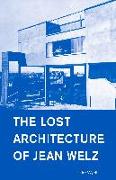- Start
- The Lost Architecture of Jean Welz
The Lost Architecture of Jean Welz
Angebote / Angebote:
An exciting mystery set in the glamorous world of Parisian modern architecture bringing to light a lost genius unknown until this book.
A treasure hunt through modern architecture featuring a virtual unknown - Jean Welz - living a hidden life among many famous names: Le Corbusier, Adolf Loos, Robert Mallet-Stevens, Gabriel Guevrekian, Tristan Tzara (founder of Dada), and photographer André Kertész.
Gorgeous avant-garde design with spot color washes, tints, and highlighted text using period fonts.
A book also for the general reader, the visual and compelling narrative style of the author/filmmaker is filled with unusual details about the drama behind architecture.
Readers gain a fascinating insight into the rich and radical artistic interwar period of the 1920s and 1930s in Paris.
The story travels across three countries and two continents over eight years of research, uncovering enigmatic clues in dusty archives, photographs, plans, drawings, family memories, and the confessions of Jean Welz, the architect-turned-artist.
Welz's Maison Zilveli with its airborne main floor, views of Sacre Coeur and the Eiffel Tower, and the lost, perilous balcony, are bold ideas that will light up readers' imaginations.
The house is due to become a gallery under new ownership by controversial Svengali-figure Jean-Paul Goude (Mr Grace Jones, Kim Kardashian's "Break the Internet" inspiration). Now an "Endangered Modern Icon" - see iconichouses.org- it would take the imagination of a Goude to restore the house to its original. This book magnificently encourages that dream.
Creates the credible fantasy that an unknown young architect brilliantly translated innovations from his native Vienna into French modern architecture of the 1920s and 1930s, challenging Le Corbusier, arguably one of the greatest architects of the 20th Century, with a stunning bravura all the more exciting for it having remained completely hidden until now.
Jean Welz could not register as an architect in France and worked "under the table, " so credit to him has to be sleuthed out through letters, interviews, signed photographs, a portfolio, and rare documents. The book feels like a race against crumbling history.
Introduces readers to an important artist (see the 1997 monograph published by the Rembrandt Foundation in Cape Town, a street is even named after him) who languished in obscurity as an architect having had to quit the profession due to the deadly threat of tuberculosis. South Africa's official "brand" site lists Jean Welz as an important artist of European origin, who "brought a detailed, nuanced and sophisticated style to still lifes, portraits, nudes, and landscape paintings. See brandsouthafrica.com.
Layers of intrigue include that the author discovers how South Africa's leading modern architect took cues from a Welz Paris house to create his best-known design. Yet he never mentions Welz, instead writing at length on his inspirations and thus effectively disappears Welz's contributions. This is bound to stir some controversy and commentary.
Color plates in the book feature some of Jean Welz's abstract paintings, which are clearly informed by architecture and marvelous to see. They will be less known than the representational work for which he is best known as they were too controversial in his time.
Another layer of intrigue - Jean Welz's brother was an infamously unscrupulous art dealer in Vienna and an SS officer.
The story of the two brothers could not be more different, and they had virtually no contact from 1936 until 1965 (and then a final break in the 1970s): Friedrich Welz in Vienna was an opportunist and did anything that was to his advantage, including coercively acquiring the best artworks from departing Jews - Klimt, Schiele, etc. - selling them to leading Nazis and later back to Austria. Meanwhile, Jean Welz was a radical who changed his name from Hans to Jean because he felt at home in the Parisian avant-garde and said he discovered his "French soul." An artist with contrasting passions to those of his dealer brother, Jean's contributions include a gravestone for Marx's daughter, destroyed by Nazis the day after Paris was occupied in 1940, and freely giving his skills for a Black South African school under Apartheid.
Jean died never knowing about his estranged brother's Nazi-dealings as it was decades before the major Aryanization art-theft scandals of the late 1990s involving Friedrich erupted in the New York Times and U.S. District Court.
The Leopold Museum in Vienna's Museumsquartier is required by the legal settlement in the United States to have a notice upon the wall that Friedrich Welz was a Nazi war criminal, despite his never being prosecuted and acquitted by an Austria that was never de-nazified.
Upon discovering this history, we come to think back on the startling, abandoned Parisian house, the Maison Zilveli, with its soaring balcony and the youthful optimism of Jean Welz, who left fusty anti-semitic Austria and found in Paris a place he could fly.
Noch nicht erschienen. Termin unbekannt
